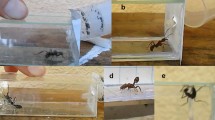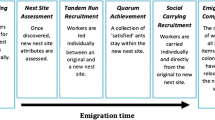Abstract
The ecological success of ants is founded on cooperative behaviour and a well functioning communication. Particularly invasive ants are able to act highly cooperatively, out-compete other species, and become ecologically dominant. Since ant communication is to a large extent chemical, we investigated the pheromone functions involved in foraging and alarm behaviour of the invasive tropical formicine Anoplolepis gracilipes. Our results suggest that long-lasting orientation cues are located in hindguts, while Dufour glands contain short-term attractants that trigger an effective recruitment. Poison gland effects were intermediate between hindgut and Dufour gland in terms of orientation, attraction and longevity. In contrast to the other pheromone sources, mandibular glands have a repellent effect and are most likely involved in alarm behaviour. Taken together, the pheromone glands of A. gracilipes contain functionally distinct signals with considerable differences in persistence. In this respect, its communication is exceptional in formicine ants. A strikingly similar communication system was previously detected in Paratrechina longicornis, another opportunistic and invasive formicine ant. Based on these similarities and the differences compared to non-invasive formicine ants, we discuss the role of chemical signals for the coordination of efficient foraging. We conclude that a sophisticated communication system can contribute significantly to ecological dominance and invasive success, in concert with other well known traits.





Similar content being viewed by others
References
Abbott KL (2005) Supercolonies of the invasive yellow crazy ant, Anoplolepis gracilipes, on an oceanic island: forager activity patterns, density and biomass. Insect Soc 52:266–273
Attygalle AB, Morgan ED (1984) Chemicals from the glands of ants. Chem Soc Rev 13:245–278
Beckers R, Deneubourg JL, Goss S, Pasteels JM (1990) Collective decision making through food recruitement. Insect Soc 37:258–267
Bonabeau E (1997) Flexibility at the edge of chaos: a clear example from foraging in ants. Acta Biotheor 45:29–50
Brady SG, Schultz TR, Fisher BL, Ward PS (2006) Evaluating alternative hypotheses for the early evolution and diversification of ants. Proc Nat Acad Sci USA 103:18172–18177
Calcaterra LA, Livore JP, Delgado A, Briano JA (2008) Ecological dominance of the red imported fire ant, Solenopsis invicta, in its native range. Oecologia 156:411–421
Carpintero S, Reyes-Lopez J (2008) The role of competitive dominance in the invasive ability of the Argentine ant (Linepithema humile). Biol Invasions 10:25–35
Cavill GWK, Robertson PL, Davies NW (1979) An Argentine ant Iridomyrmex humilis aggregation factor. Experientia 35:989–990
Cavill GWK, Davies NW, McDonald FJ (1980) Characterization of aggregation factors and associated compounds from the Argentine ant, Iridomyrmex humilis. J Chem Ecol 6:371–384
Colautti RI, Ricciardi A, Grigorovich IA, MacIsaac HJ (2004) Is invasion success explained by the enemy release hypothesis? Ecol Lett 7:721–733
Cremer S, Ugelvig LV, Lommen STE, Petersen KS, Pedersen JS (2006) Attack of the invasive garden ant: aggression behaviour of Lasius neglectus (Hymenoptera: Formicidae) against native Lasius species in Spain. Myrmecol Nachr 9:13–19
Davidson DW (1998) Resource discovery vesus resource domination in ants: a functional mechanism for breaking the trade-off. Ecol Entomol 23:484–490
Dejean A, Kenne M, Moreau CS (2007) Predatory abilities favour the success of the invasive ant Pheidole megacephala in an introduced area. J Appl Entomol 131:625–629
Deneubourg JL, Goss S (1989) Collective patterns and decision-making. Ethol Ecol Evol 1:295–311
Dussutour A, Nicolis SC, Shephard G, Beekman M, Sumpter DJT (2009) The role of multiple pheromones in food recruitment by ants. J Exp Biol 212:2337–2348
Errard C, Delabie J, Jourdan H, Hefetz A (2005) Intercontinental chemical variation in the invasive ant Wasmannia auropunctata (Roger) (Hymenoptera Formicidae): a key to the invasive success of a tramp species. Naturwissenschaften 92:319–323
Evison SEF, Petchey OL, Beckerman AP, Ratnieks FLW (2008) Combined use of pheromone trails and visual landmarks by the common garden ant Lasius niger. Behav Ecol Sociobiol 63:261–267
Fellers JH (1987) Interference and exploitation in a guild of woodland ants. Ecology 68:1466–1478
Giraud T, Pedersen JS, Keller L (2002) Evolution of supercolonies: the argentine ants of southern Europe. Proc Nat Acad Sci USA 99:6075–6079
Hill M, Holm K, Vel T, Shah NJ, Matyot P (2003) Impact of the introduced yellow crazy ant Anoplolepis gracilipes on Bird Island, Seychelles. Biodivers Conserv 12:1969–1984
Hölldobler B (1995) The chemistry of social regulation: multicomponent signals in ant societies. Proc Nat Acad Sci USA 92:19–22
Hölldobler B, Lumsden CJ (1980) Territorial strategies in ants. Science 210:732–739
Hölldobler B, Wilson EO (1990) The ants. The Belknap Press of Harvard University Press, Cambridge
Holway DA (1999) Competitive mechanisms underlying the displacement of native ants by the invasive Argentine ant. Ecology 80:238–251
Holway DA, Lach L, Suarez AV, Tsutsui ND, Case TJ (2002) The causes and consequences of ant invasions. Annu Rev Ecol Syst 33:181–233
Human KG, Gordon DM (1996) Exploitation and interference competition between the invasive Argentine ant, Linepithema humile, and native ant species. Oecologia 105:405–412
Jackson BD, Morgan ED (1993) Insect chemical communication: pheromones and exocrine glands of ants. Chemoecology 4:125–144
Jackson DE, Ratnieks FLW (2006) Communication in ants. Curr Biol 16:R570–R574
Jackson DE, Martin SJ, Holcombe M, Ratnieks FLW (2006) Longevity and detection of persistent foraging trails in Pharaoh’s ants, Monomorium pharaonis (L.). Anim Behav 71:351–359
Jackson DE, Bicak M, Holcombe M (2008) A paradigm for self-organisation: new inspiration from ant foraging trails. In: Proceedings of the fifth IEEE international workshop on engineering of autonomic & autonomous systems (Ease 2008), pp 86–94
Jaffe K (1980) Theoretical analysis of the communication system for chemical mass recruitment in ants. J Theor Biol 84:589–609
Jaffe K (1984) Negentropy and the evolution of chemical recruitment in ants. J Theor Biol 106:587–604
Jeschke JM, Strayer DL (2005) Invasion success of vertebrates in Europe and North America. Proc Nat Acad Sci USA 102:7198–7202
Kolar CS, Lodge DM (2001) Progress in invasion biology: predicting invaders. Trends Ecol Evol 16:199–204
Lach L (2005) Interference and exploitation competition of three nectar-thieving invasive ant species. Insect Soc 52:257–262
LeBrun EG, Tillberg CV, Suarez AV, Folgarait PJ, Smith CR, Holway DA (2007) An experimental study of competition between fire ants and argentine ants in their native range. Ecology 88:63–75
Lowe S, Browne M, Boudjelas S, Poorter MD (2000). 100 of the world’s worst invasive alien species. In: A selection from the Global Invasive Species Database (ISSG) a specialist group of the Species Survival Commission (SSC) of the World Conservation Union (IUCN). Available at http://www.issg.org/booklet.pdf. Accessed 30 Aug 2006
Lynch JF, Balinsky EC, Vail SG (1980) Foraging patterns in three sympatric forest ant species, Prenolepis imparis, Paratechina melanderi and Aphaenogaster rudis (Hymenoptera: Formicidae) Anne Arundel County, Maryland. Ecol Entomol 5:353–371
McGlynn TP (1999) Non-native ants are smaller than related native ants. Am Nat 154:690–699
Moller H (1996) Lessons for invasion theory from social insects. Biol Conserv 78:125–142
Morgan ED (2008) Chemical sorcery for sociality: exocrine secretions of ants (Hymenotera: Formicidae). Myrmecol News 11:79–90
Morgan ED (2009) Trail pheromones of ants. Physiol Entomol 34:1–17
Morrison LW (2000) Mechanisms of interspecific competition among an invasive and two native fire ants. Oikos 90:238–252
O’Dowd DJ, Green PT, Lake PS (2003) Invasional meltdown on an oceanic island. Ecol Lett 6:812–817
Passera L (1994) Characteristics of tramp species. In: Williams DF (ed) Exotic ants: biology, impact, and control of introduced species. Westview Press, Boulder, pp 23–43
Ritter FJ, Rotgans IEM, Talman E, Verwiel PEJ, Stein F (1973) 5-methyl-3-butyl-octahydroindolizine, a novel type of pheromone attractive to Pharaoh’s ants (Monomorium pharaonis (L.). Experientia 29:530–531
Ritter FJ, Brüggemann-Rotgans IEM, Verwiel PEJ, Persoons CJ, Talman E (1977) Trail pheromone of the Pharaoh’s ant, Monomorium pharaonis: isolation and identification of faranal, a terpenoid related to juvenile hormone II. Tetrahedron Lett 30:2617–2618
Robertson PL, Dudzinski ML, Orton CJ (1980) Exocrine gland involvement in trailing behaviour in the Argentine ant (Formicidae: Dolichoderinae). Anim Behav 28:1255–1273
Robinson EJH, Green KE, Jenner EA, Holcombe M, Ratnieks FLW (2008) Decay rates of attractive and repellent pheromones in an ant foraging trail network. Insect Soc 55:246–251
Talman E, Ritter FJ, Verwiel PEJ (1974) Structure elucidation of pheromones produced by the pharaoh’s ant, Monomorium pharaonis. In: Frigerio A, Castagnoli N (eds) Mass spectrometry in biochemistry and medicine. New York, pp 197–217
Tanner CJ (2006) Numerical assessment affects aggression and competitive ability: a team-fighting strategy for the ant Formica xerophila. Proc R Soc Lond B Biol Sci 273:2737–2742
Torchin ME, Lafferty KD, Dobson AP, McKenzie VJ, Kuris AM (2003) Introduced species and their missing parasites. Nature 421:628–630
Tsutsui ND, Suarez AV (2003) The colony structure and population biology of invasive ants. Conserv Biol 17:48–58
Van Vorhis Key SE, Baker TC (1982) Trail-following responses of the Argentine ant, Iridomyrmex humilis (Mayr), to a synthetic trail pheromone component and analogs Insect behavior, pests. J Chem Ecol 8:3–14
Vander Meer RK (1983) Semiochemicals and the red imported fire ant (Solenopsis invicta Buren) (Hymenoptera: Formicidae). Fla Entomol 66:139–161
Wilson EO (1990) Success and dominance in ecosystems: the case of the social insects. Excellence in ecology, vol 2. Ecology Institute, Oldendorf
Witte V, Abrell L, Attygalle AB, Wu X, Meinwald J (2007a) Structure and function of Dufour gland pheromones from the crazy ant Paratrechina longicornis. Chemoecology 17:63–69
Witte V, Attygalle AB, Meinwald J (2007b) Complex chemical communication in the crazy ant Paratrechina longicornis Latreille (Hymenoptera: Formicidae). Chemoecology 17:57–62
Acknowledgments
We thank our group members for fruitful discussions and valuable comments on the manuscript.
Author information
Authors and Affiliations
Corresponding author
Electronic supplementary material
Below is the link to the electronic supplementary material.
Rights and permissions
About this article
Cite this article
Lizon à l’Allemand, S., Witte, V. A sophisticated, modular communication contributes to ecological dominance in the invasive ant Anoplolepis gracilipes . Biol Invasions 12, 3551–3561 (2010). https://doi.org/10.1007/s10530-010-9750-7
Received:
Accepted:
Published:
Issue Date:
DOI: https://doi.org/10.1007/s10530-010-9750-7




